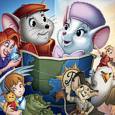 We all remember the majesty and lyricism of Cody’s flight with Marahute: released in 1990, The Rescuers Down Under was the first sequel in the Disney Studio’s history and the first non-musical since Victory Through Air Power in 1943.
We all remember the majesty and lyricism of Cody’s flight with Marahute: released in 1990, The Rescuers Down Under was the first sequel in the Disney Studio’s history and the first non-musical since Victory Through Air Power in 1943.
For the 35th anniversary of the theatrical release of the original film, Disney has released both Rescuers movies to Blu-ray prompting, for us, an opportunity to talk with one of the creators of Down Under, composer Bruce Broughton.
One of the most versatile composers working today, Bruce Broughton writes in every medium, from theatrical releases and TV feature films to the concert stage and computer games.
His first major film score, for the Lawrence Kasdan Silverado, brought him an Oscar nomination. His very next project, a classically styled score for Barry Levinson’s Young Sherlock Holmes, earned a Grammy nomination for the soundtrack album.
With over 20 Emmy nominations, Bruce Broughton has received a record 10. He’s also won Emmys for Eloise at Christmastime; Eloise at The Plaza and the Tiny Toon Adventures Theme Song among others. He is a board member of ASCAP, a governor of the Academy of Motion Picture Arts and Sciences, a former governor of the Academy of Television Arts and Sciences, and past president of The Society of Composers and Lyricists. He has taught film composition in the Advanced Film Music Studies program at USC and is a frequent lecturer at UCLA.
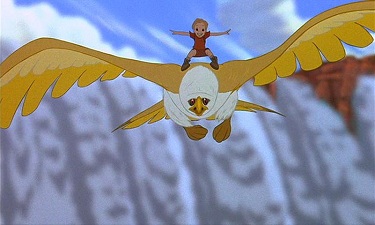
Animated Views: What do you remember of the original first Rescuers film?
Bruce Broughton: I remember thinking it was a cute film.
AV: How did you end up being involved in the sequel and why did you accept?
BB: The producers were attracted to me because of my score for Silverado. This film was different from the other Disney animation films in that it was a straight-forward adventure. It had no songs.
AV: What was the production like?
BB: We recorded three or four cues before the scoring session. This was to give everyone an idea of what I was doing. Jeffrey Katzenberg didn’t like the direction I was taking, so I had to rewrite what I had done, which up to this time was about a third of the film. The process actually made the score stronger, however. Some cues were kept – Frank’s Out was one of them, as I remember.
AV: Where there any other specific requirements Disney asked for the score?
BB: A major request of Mr. Katzenberg was that the score sound as ethnic as possible. This in fact was a little hard to do since the Australian aborigines don’t have a lot of instruments to pick from. As far as I knew, they used the digeridoo and the boomerang as instruments. So the “ethnic” part of the score was taken from anything I could find: African instruments, South American, North American and Asian instruments. The score was about as ethnically authentic as the Australian accents of the characters in the film!
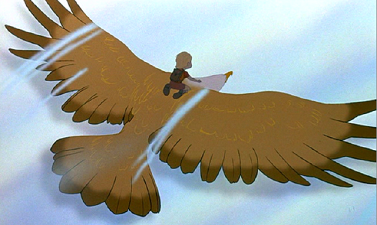
AV: How did you work with directors Hendel Butoy and Mike Gabriel?
BB: I couldn’t say enough good things about these two. They’re both wonderful guys, who are terrific animators themselves. They were always very clear about what they wanted and were always concerned that the film be as good as humanly possible.
AV: As always, your themes are beautiful, especially the one for Marahute, in that stunning flight scene with Cody!
BB: This is a theme that just fell out of my fingers, though I had gone on a search for it. The idea was to find a theme that was expansive enough to play the thrill of the flying, which is after all a typical boyish fantasy.
This had always been seen as one of the primary scenes of the film. Glen Keane was the animator for it. He and I, along with Hendel Butoy and Mike Gabriel, the film’s two directors, and Tom Schumacher, the film’s producer, spent a lot of time talking about the scene, what it would be, how it would look and how it would sound. We even considered using a boy’s choir for a short while. I eventually wrote a version of it so that they could animate to the music, but that idea was soon dropped. I think they did better by coming up with the picture first and then letting me add the music.
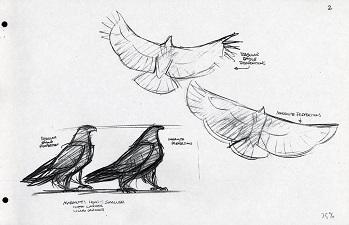
AV: Then is the adventurous “Message Montage” theme, when the “Help” message is transmitted to New York.
BB: The film is primarily an adventure film, so this particular theme had to be strong enough to hold the dramatic idea and yet provide some contrast with the flying theme. This tune is much more straightforward and much less “religious” in tone. Its dotted rhythms help snap the tune forward, whereas the Marahute theme is built with longer, more sustained melodic lines and harmonies.
AV: Bernard and Bianca have a new theme that’s very cute.
BB: This little theme was an intentional throw-back to the kinds of Disney themes that used to accompany their animated films from the 40s. It’s very gentle and very old-fashioned, like the relationship that exists between Bernard and Bianca.
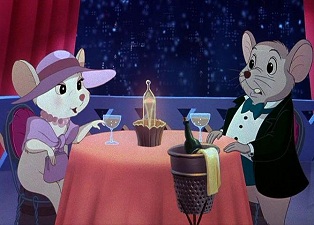
AV: Then again, the villain McLeach has no theme of his own…
BB: It wasn’t so necessary to find a theme for McLeach, though I had a snake-like motif for his lizard assistant, who was a much more interesting character. McLeach’s machinery was an important part of the story, so I fashioned a mechanistic motive for that. There was a lot of conversation about McLeach’s machine, what it would sound like, what it would do. Except for the computer generated aspects of the vehicle itself (which were pretty substantially engineered and rendered) the character of the machine was pretty much left up to the music.
I’ve rarely found it necessary or even desirable to compose a theme for characters. When an actor appears, the audience can see the actor is present; why play a theme to redundantly announce the entry? I’ve generally chosen themes to represent dramatic ideas in the movie. The big themes in Rescuers were chosen along these lines: the thrilling quasi-religious feelings connected with flying, the adventure of the story, the relationship between the two mice, the nastiness of the lizard and the powerful unemotional muscle of McLeach’s thievery.
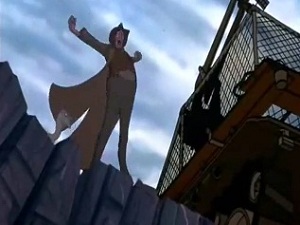
AV: There’s also the Rescue Aid Society theme.
BB: The Rescue Aid Society theme, which is the only musical nod to the first film, is a real theme song. It’s a cute and enthusiastic song, the kind of thing people would sing at an organizational get-together. It’s also very short.
AV: Although very modern in its making, The Rescuers Down Under seems rather classic, in the best sense, in its spirit.
BB: There are many places in the movie in which the animation is underscored in an old-fashioned way. These are primarily the scenes in which the animals are the focus, for instance most of the scenes involving the mice – including the big rescue notice sent from Australia to New York – anything involving Wilbur and his flying and most of the rescue action itself. Those scenes in which animated humans were prominent were treated more like a live-action film. So, there is a lot of traditional animation music in this movie. I think that it’s the best way to give animation some punch.
These movies are incredibly well drawn and can appear very, very realistic. But in fact, all of the actions has been telescoped in time because the movements have been drawn, not photographed. The movement in animation is that of heightened realism, and to me the best way to pay it off is to highlight that energy with the music itself. One can really see this when animators animate to music. Writing music of this sort is really tedious, since every frame of film has to be accounted for and musical movements and transitions have to be made extraordinarily quickly. In my case, I still try as much as possible to make the cue sound like music, not just action support. But I think that when it works, it works great.
I could probably say that this film was the last Disney animated film to be so treated. Most of the films since then have been pretty much scored like a live action film in which the movements of the characters are not highlighted by the music.
 AV: The sequence of the eggs between Joanna and McLeach is very good, and has no music.
AV: The sequence of the eggs between Joanna and McLeach is very good, and has no music.
BB: There was music written for that scene, but it was dropped during the dubbing session.
AV: Did that aspect and the visual and technical prowess of the movie leave you enough room for emotion?
BB: I think that there was probably more emotion in the movie than it seems. The opening credits are fairly emotional, the flying sequence is obviously very emotional, and there are several other scenes where there is a lot of warmth and/or humor. However, the movie didn’t go so directly for the heart as the first one did, and probably a lot of charm was lost. The movie was geared for adventure. In cases like these, all you can do is play the film and the film’s intentions. The movie isn’t remembered as being a heartless techno exercise.
AV: As you say, this isn’t a musical: there are no songs in this particular movie.
BB: This was a Disney choice and was made before I was part of the team. It’s the only Disney animated film as far as I know that didn’t have a song in it. The movie after this was Beauty and the Beast. Compare the success of the two films.
AV: You told me about Jeffrey Katzenberg’s desire to have the score of the movie as ethnic as possible. Can you tell me about that aspect?
BB: I found as many opportunities as were reasonable to bang or plunk on something that came from somewhere, but not necessarily from Australia. I don’t remember now what a lot of the instruments were, but there was a rain stick, a berimbao, several different kinds of Brazilian bird whistles, a pueli stick, a devil chaser, a wind wand, bones, various African mallets, thumb pianos, many different sorts and sizes of drums large and small – you name it. They were all played by Los Angeles session musicians.
AV: How did you choose those instruments ?
BB: I spent a lot of time with some percussionists to see what they had. They played, and I listened and made notes.
AV: The Rescuers Down Under is not your only participation in an animated film, especially of that early 1990s era. To you, what are the relations – and the differences – between your work on The Rescuers Down Under and, say, on the Tiny Toons?
BB: Rescuers is a much more sophisticated score and film than anything in Tiny Toon Adventures, which was an homage to the style of Carl Stalling. Stalling’s style was brilliantly slapstick and enormously inventive musically. The Tiny Toons music is sort of like vaudeville, whereas the Rescuers score is more like a concert hall. The Disney people weren’t too thrilled about my association with Tiny Toons, but I have to say I enjoyed working on them a lot. I could be very silly, musically. However, I wrote some very similar styled music for the two Roger Rabbit cartoons I did. They were both done in an old-fashioned cartoon style. Music on amphetamines! There’s also a long sequence in that style in the movie Stay Tuned.

AV: You were also the conductor of the Rhapsody in Blue sequence of Fantasia 2000. Would you share some memories of this time? It must have been a very special experience!
BB: The problem on this project was to find a pianist who could play in synch with an animated film track. I asked Ralph Grierson to do it, because he has the widest range of any studio player I’ve come across. He has literally played every style from Messian, Stravinsky and Steve Reich to barmitzvahs. We had to very carefully time the music to fit Eric Goldberg’s sketches and action. Eric was very specific about what he wanted where. The trick was to make the music sound improvised and free, even though all of the timing was tightly controlled. It was a lot of fun.
AV: How did you come on to that project?
BB: I had done another musical reconstruction for Disney a few years earlier, and the music department called me for this.
 AV: How did you work with Eric Goldberg?
AV: How did you work with Eric Goldberg?
BB: It’s kind of hard not to have a good time with Eric. He’s a spectacular artist who works quickly and knows very much about where he is going artistically and what he wants. He was very specific about the performance of the Rhapsody, and oversaw the recording.
AV: Did you make some modifications to the original score by Gershwin?
BB: Some of the solo piano sections were cut. This was only for reasons of time.
AV: Is there an “animated” way to conduct for an animated film?
BB: Do you mean, do you have to jump up and down while you conduct? Not really! There’s just a lot more notes to play and to look at. Timing, accuracy and emotional weight are the most important qualities in animation music.
AV: What do you like in animation music, compared to live-action?
BB: I tend to do animation in an old-fashioned way, because I think it works better. Because there’s no real weight to an animated character and every expression is drawn a frame at a time, sometimes the music has to animate the animation – that is to say, the music helps bring the drawings to life. I enjoy animation. I enjoy the fantasy of it and the pacing. I like the energy in the music, especially when I’m permitted to do it that way. I think the picture becomes tremendously exciting when the drawing and the music are locked together.
Live action is very different. In that case, the actual action is not so important as the content of the feeling. It’s not necessary to “Mickey Mouse” things to make a point. As animation becomes more realistic, there is a tendency to treat it like live action, but it’s just not the same thing. I have seen more soppy feeling in animated movies as a result of trying to pretend it’s the real thing by giving it a live action score.
available to order now from Amazon.com
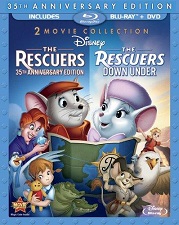
Our thanks and deepest admiration to Mr Broughton.




